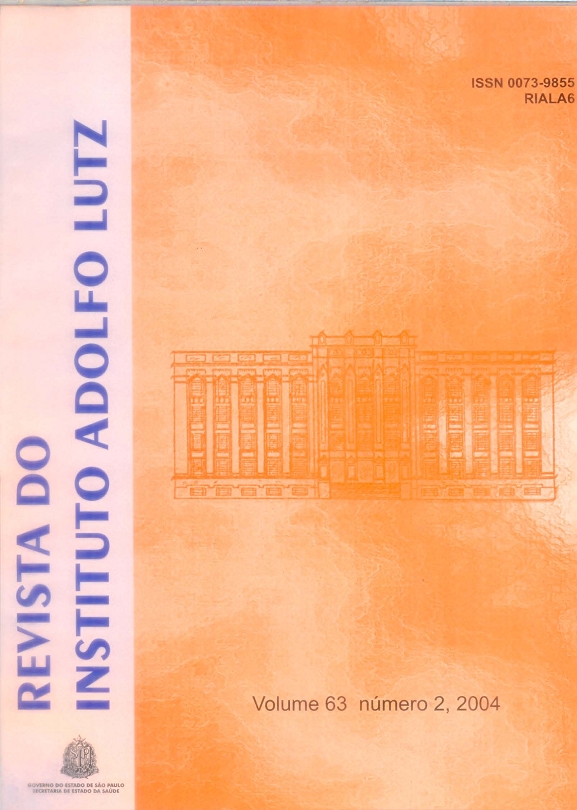Abstract
During the summer and winter of 2003, 200 samples of water used for hemodialysis procedures collected from two hospitals A and B were analyzed. The water samples were collected from the following sites: P1 - from incoming public treated water, from city water mains (N=18 samples); P2 - from pre-treatment site (N=18); P3 - from reverse osmosis (OR) treatment site (N=18); P4 - from hemodialysis machine water entry site (N=28); P5 - pre-dialyzing solution (N=30); P6 - from post-dialyzing site with arterial and venous blood lines (N=17); P7- from loop (N=9); P8 - from carbon filter (N=11); P9 - from reuse C site (N=18); P10 – from reuse B site (N=18); and P11- from water storage tank for OR (N=11). The analyses were performed according to the methodology recommended in the Standard Methods for the Examination of Water and
Wastewater, 1995, by means of the following assays: pour plate technique for heterotrophic bacteria (BH) counting in R2A agar; filter membrane technique for Pseudomonas aeruginosa detection in Cetrimide agar; culture in Sabouraud agar for yeast; technique for fluoride and conductivity determination; determination of sulfate and nitrate performed according to “Normas Analíticas do Instituto Adolfo Lutz”
(Instituto Adolfo Lutz Analytical Guidelines), 1985...
References
1. Amato, R.L. Water Treatment for Hemodialysis, Including the Latest AMMI Standards. J Neprol Nurs, 28:612-9,2001.
2. Arvanitidou, M. et al. High level of recovery of fungi from water and dialysate in haemodialysis units. J. Hospital Infection, 45: 225-30, 2000
3. Arvanitidou, M et al. Occurrence and antimicrobial resistance of Gramnegative bacteria isolated in haemodialysis water and dialysate of renal units: results of a Greek multicentre study. J. Applied Microbiology, 95:180-5, 2003.
4. Azevedo, S.M et al. Human intoxication by microcystins during renal dialysis treatment in Caruaru-Brazil. Toxicology, 182: 441-446,2002.
5. Bambauer, R. et al. Contamination of dialysis water and dialysate. A survey of 30 centers. ASAIO J., 40: 1012-6,1994.
6. Brasil, Agência Nacional de Vigilância Sanitária, Resolução Diretoria Colegiada Nº154, - Diário Oficial da União, de 17 de junho de 2004, Brasília; Seção 1, p.65-9.
7. Brasil, Portaria N° 518, de março de 2004, Gabinete do Ministro – Ministério Da Saúde, Diário Oficial da União, Brasília n° 59 de 26/03/2004, Seção 1, pág. 266 –70
8. Brem, A. Fungal peritonitis in patient on continuous ambulatory peritonial dialysis. Europ. J.Clin.Microbio.Infect.Disease, 17: 839-43, 1998
9. Cappelli, G. et al. Biofilms invade nephrology: effects in hemodiálisis. J. Blood Purif, 18(3):224-30, 2000.
10. Capelli, G. et al. C. Effects of biofilm formation on haemodialysis monitor disinfection. J. Nephrol Dial Transplant, 18(10): 2105-11, 2003.
11. Center For disease Control & Prevention, USA e World Health Organization, Geneva, Switzerland. Epi Info 6, 1994; version 6.02.
12. Eaton, A.D. et al. Standard Methods for Examination of Water and Wastewater, Washington, DC. (APHA). 19th ed., 1995.
13. Favero, M.S. et al.. Dialysis-associated infections and their control. J. Hospital Infection, 24: 357-78,1998.
14. Instituto Adolfo Lutz. Normas Analíticas do Instituto Adolfo Lutz. Métodos Químicos e Físico para Análise de Alimentos. São Paulo. 3a.ed., Sulfato e Nitrato, 1985; V.1, p.302-30.
15. Kurtzman, C.P. e Fell, J.W.. The yeasts: a taxonomic study, New York, 1998.
16. Linde, K. et al. Improved bacteriological surveillance of haemodialysis fluids: a comparison between Tryptic soy agar and Reasoner’s 2A media. Nephrol Dial Transplant, 14: 2433-7, 1999.
17. Oie, S. et al. Microbial contamination of dialysate and its prevention in haemodialysis units. J. Hospital Infection, 54:115-9, 2003.
18. Palleroni, N.J. Genus I – Pseudomonas. Bergey’s Manual of systematic bacteriology. Baltimore: William & Wilkins, 1986, p.141-99.
19. Pisan, B. et al. Surto de bacteriemia por Pseudomonas aeruginosa na Unidade de Hemodiálise de um hospital de Campinas, São Paulo, Brasil. Rev. Inst. Adolfo Lutz, 59(1/2): 51-6, 2000.
20. São Paulo, Secretaria de Estado da Saúde, Centro de Vigilância. Roteiro de Inspeção da Vigilância Sanitária de Serviços de Terapia renal Substitutiva, 1997.
21. Silva, A.M.M. et al. Revisão/Atualização em Diálise: Água para hemodiálise. J. Bras. Nefrol. 18 (2):180-8,1996.
22. Teixeira, P et al.. Evaluation Of Survival Patterns And Cellular Injury Of Pseudomonas aeruginosa In Different Bottled Waters Stored Under Various Conditions. J. Food Safety. 21: 167-80,
23. USA, Pharmacopeia, USP XXIV, Rockville, Twinbrook Parkway, Bacterial Endotoxins Test, 1995; 24:1829-30.

This work is licensed under a Creative Commons Attribution 4.0 International License.
Copyright (c) 2004 Revista do Instituto Adolfo Lutz
